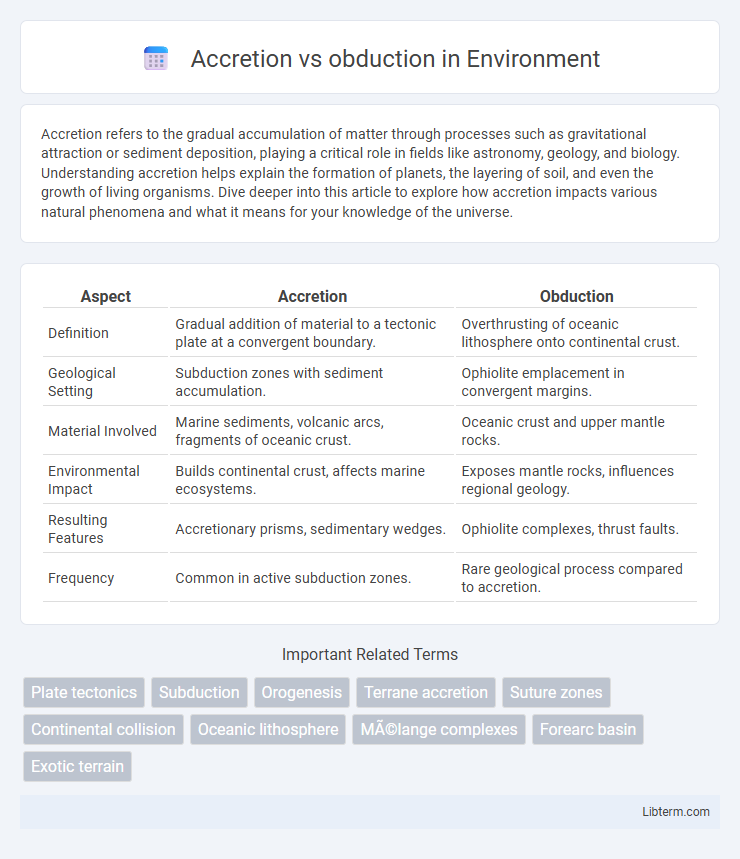Accretion refers to the gradual accumulation of matter through processes such as gravitational attraction or sediment deposition, playing a critical role in fields like astronomy, geology, and biology. Understanding accretion helps explain the formation of planets, the layering of soil, and even the growth of living organisms. Dive deeper into this article to explore how accretion impacts various natural phenomena and what it means for your knowledge of the universe.
Table of Comparison
| Aspect | Accretion | Obduction |
|---|---|---|
| Definition | Gradual addition of material to a tectonic plate at a convergent boundary. | Overthrusting of oceanic lithosphere onto continental crust. |
| Geological Setting | Subduction zones with sediment accumulation. | Ophiolite emplacement in convergent margins. |
| Material Involved | Marine sediments, volcanic arcs, fragments of oceanic crust. | Oceanic crust and upper mantle rocks. |
| Environmental Impact | Builds continental crust, affects marine ecosystems. | Exposes mantle rocks, influences regional geology. |
| Resulting Features | Accretionary prisms, sedimentary wedges. | Ophiolite complexes, thrust faults. |
| Frequency | Common in active subduction zones. | Rare geological process compared to accretion. |
Introduction to Accretion and Obduction
Accretion and obduction are geological processes that describe the interaction between tectonic plates at convergent boundaries. Accretion involves the gradual addition of sediment, oceanic crust, or terranes to a continental margin, increasing its landmass over time, while obduction refers to the overthrusting of oceanic lithosphere onto continental crust, a rare process contrasting with typical subduction. Understanding these phenomena is crucial for interpreting mountain-building events, plate tectonics, and the evolution of Earth's crust.
Defining Accretion: Geological Context
Accretion in geology refers to the process where material is added to a tectonic plate or landmass at convergent boundaries, often forming new crust through sediment accumulation or volcanic activity. This phenomenon contrasts with obduction, where oceanic crust is thrust over continental crust, rather than being subducted beneath it. Accretionary prisms commonly develop in subduction zones, contributing to mountain building and continental growth.
Understanding Obduction: Key Mechanisms
Obduction involves the overthrusting of oceanic lithosphere onto continental margins, often forming ophiolite complexes that provide crucial evidence of seafloor processes. This mechanism requires compressional tectonic forces driving the emplacement of denser oceanic crust above lighter continental crust, contrasting the typical subduction that pulls oceanic plates beneath continents. Understanding obduction helps geologists interpret orogenic events and reconstruct ancient plate boundary dynamics by analyzing associated rock assemblages and structural features.
Tectonic Plate Boundaries and Their Role
Accretion occurs at convergent plate boundaries where oceanic crust collides with continental crust, causing sediment and crustal fragments to attach to the continental margin, thereby expanding the continent. Obduction involves the direct thrusting of oceanic lithosphere onto continental lithosphere, forming ophiolite complexes typically found at convergent boundaries with compressional forces. Both processes are critical in shaping tectonic plate boundaries, influencing mountain building, crustal deformation, and the geological evolution of orogenic belts.
Accretionary Wedges and Marine Sediments
Accretionary wedges form at convergent plate boundaries where marine sediments and oceanic crust are scraped off the subducting slab and accumulated onto the overriding plate, creating a wedge-shaped mass. These wedges contain thick deposits of marine sediments that are intensely deformed and metamorphosed due to tectonic forces and pressure. The continuous accretion process plays a crucial role in crustal growth and the formation of complex geological structures in subduction zones.
Ophiolites and Evidence of Obduction
Ophiolites serve as key geological evidence supporting obduction, representing oceanic crust and upper mantle thrust onto continental margins rather than being subducted. The obduction process contrasts with accretion, where oceanic material is scraped off and added to continents at convergent boundaries without large-scale emplacement of oceanic lithosphere. Textural and structural features within ophiolites--such as sheeted dike complexes, pillow basalts, and high-pressure metamorphic rocks--demonstrate their formation through obduction rather than simple sediment accretion.
Accretion vs Obduction: Fundamental Differences
Accretion involves the gradual growth of a tectonic plate as sediments and oceanic crust are scraped off and added to the continental margin at a convergent boundary. Obduction, in contrast, refers to the emplacement of oceanic lithosphere onto continental crust, a process occurring during specific tectonic collisions and marked by the presence of ophiolites. These fundamental differences highlight accretion as a constructive process building continental margins, while obduction represents a tectonic juxtaposition of oceanic and continental rocks.
Real-World Examples of Accretion
Accretion occurs at convergent plate boundaries where oceanic crust is scraped off and added to continental margins, as seen in the formation of the Franciscan Complex along the California coast. The accretionary wedge of the Cascadia subduction zone in the Pacific Northwest exemplifies sediment and oceanic crust piling up against the continent, creating complex geological structures. Unlike obduction, which involves the thrusting of oceanic lithosphere onto continental crust, accretion builds landmasses through progressive sediment accumulation and tectonic sediment accretionary prisms.
Notable Case Studies of Obduction
Notable case studies of obduction include the Semail Ophiolite in Oman, one of the largest and best-exposed obducted oceanic lithosphere sections, providing critical insights into tectonic processes and mantle-crust interactions. The Troodos Ophiolite in Cyprus serves as a prime example of obduction, revealing a complete oceanic crust sequence and offering valuable data on seafloor spreading and tectonic uplift. These obduction complexes contrast with accretionary prisms by representing oceanic crust thrust onto continental margins rather than sediment accumulation from subduction zones.
Geological Significance and Impacts
Accretion involves the gradual addition of material to a tectonic plate at convergent boundaries, contributing to the growth of continents through processes such as sediment accumulation and terrane welding. Obduction refers to the unusual emplacement of oceanic lithosphere onto continental crust, forming ophiolites that provide critical evidence of ancient tectonic plate interactions. Both processes significantly shape mountain-building events, influence regional metamorphism, and inform the reconstruction of plate tectonic history.
Accretion Infographic

 libterm.com
libterm.com